By Lambert Strether of Corrente.
The news is a bit much to process, even for me, so I thought I’d do something completely different. I keep saying, of the plants that readers send in, “This is my favorite flower!” So here are fourteen. (The images I gathered over the web; they are not from my own garden[1], or from readers, sadly, because my file-naming convention for plant images is not sufficiently robust, dang.) In alphabetical order:
Bee Balm (via).
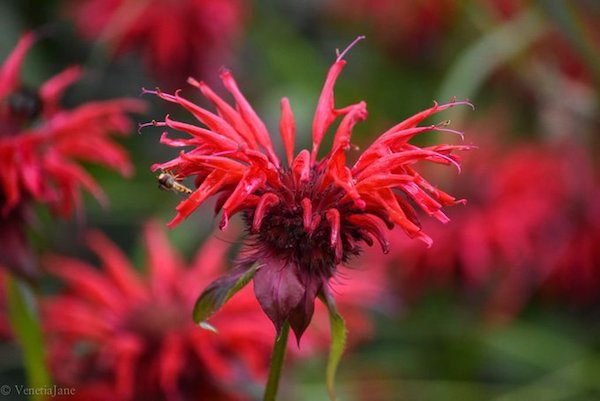
Bee balm is a terrific perennial, because its bright red color attracts hummingbirds; indeed, if I wear a red shirt or sweater, the hummingbirds dive bomb me! In one of the few true plant facts I have retained, its square stem means it belongs to the mint family. Bee balm grows in clumps that are easy to break up and transplant, so you can provide your hummingbirds with multiple targets of opportunity over the seasons.
Black-Eyed Susan
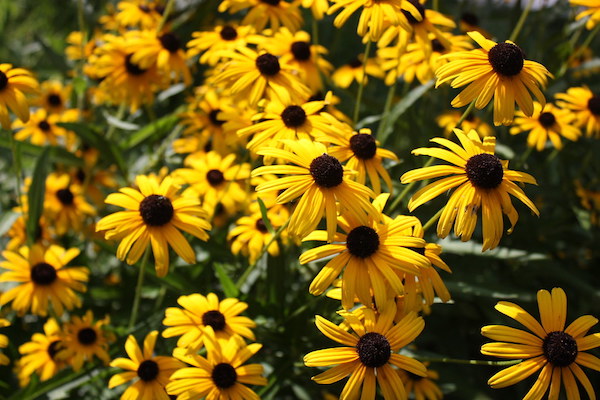
I grew up in the Midwest, and one of my earliest memories is driving West through the corn fields past drainage ditches full of Black-Eyed Susans. Black-Eyed Susans are another perennial that grows in clumps, so you can transplant patches of spot color all round your property. (I like massed color in a garden; it’s a pleasure, and easy to do.)
Clover
White clover is flowering again! Please let it flower. In the UK, its leaves are a food plant of the Common Blue butterfly, and its nectar-rich flowers are sought after by all kinds of bumblebees – including this awesome little pollinator in our garden today! ? pic.twitter.com/HiwmXJ43Nh
— Little Green Space ? (@LGSpace) June 9, 2019
White clover, an annual, is the very first thing I plant; I get a couple of pounds of seed, dig up and rake the earth around the periphery of the garden proper, and scatter the seed thickly. In a fine example of stacking functions, the clover outcompetes weeds, at least for a time; supplies nectar to pollinators, as we see; and decoys critters like deer, who eat the clover and go away, instead of venturing further into the garden.
Columbine (via).
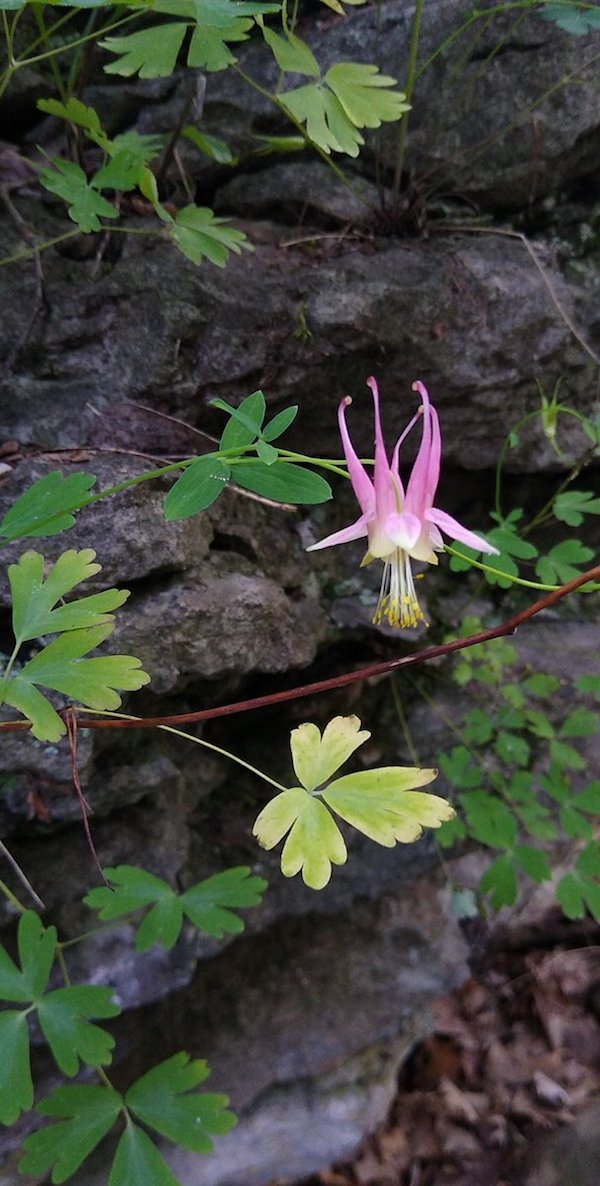
Columbines are self-seeding perennials and hence, in their own shy way, invasive. (The photograph shows columbine growing among the rocks; for some reason, that’s where my Columbine like to grow, too.) The graceful and old-fashioned Columbine flowers always remind me of dancers, because in one of the Doctor Doolittle books, a pantomime character named “Columbine,” played by Dab Dab the duck, is dressed in a pink tutu.
Forsythia (via).
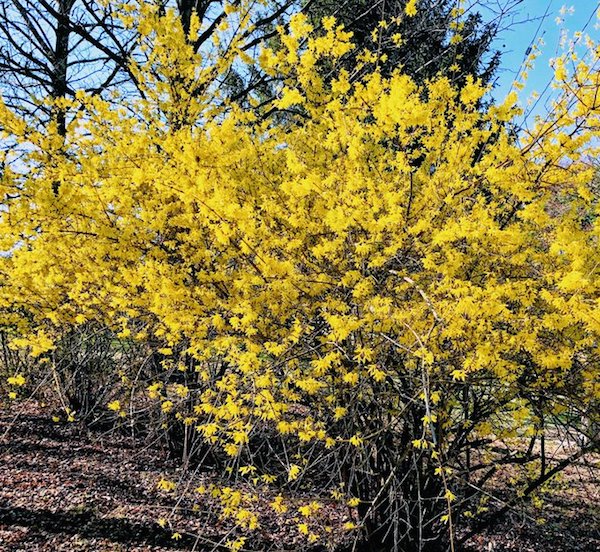
I always feel that Spring has really arrived when the Forsythia (perennial) fires. Except now the Forsythia has gotten all confused, and blooms in September, too.
Honeysuckle (via).
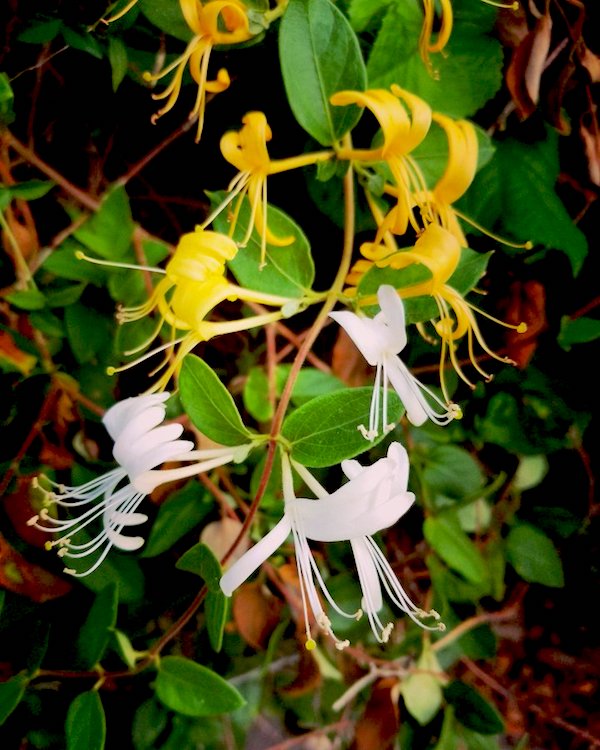
My Southern friends expressed amazement when they discovered I actually had to grow the extremely vigorous honeysuckle; but I originally had three varieties, and the Maine winter eradicated two. They too have old-fashioned and graceful flowers, and pollinators like them.
Iris (via).
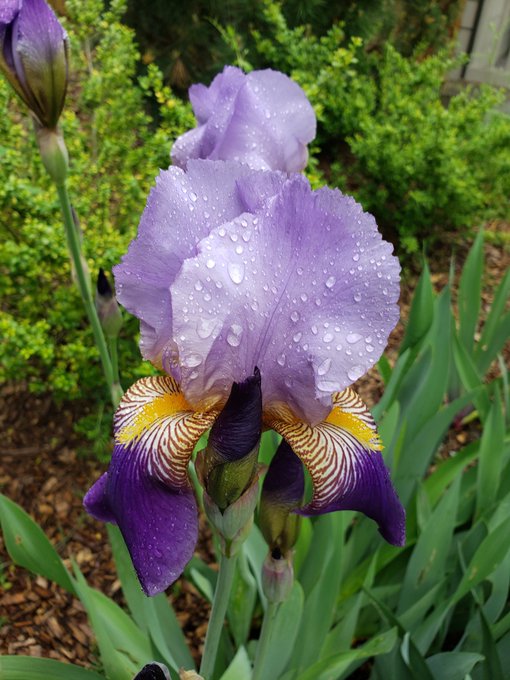
Lovely, fragrant, fleeting, and generally somebody else’s, because I can’t be bothered to dig up the bulbs and divide them.
Peony
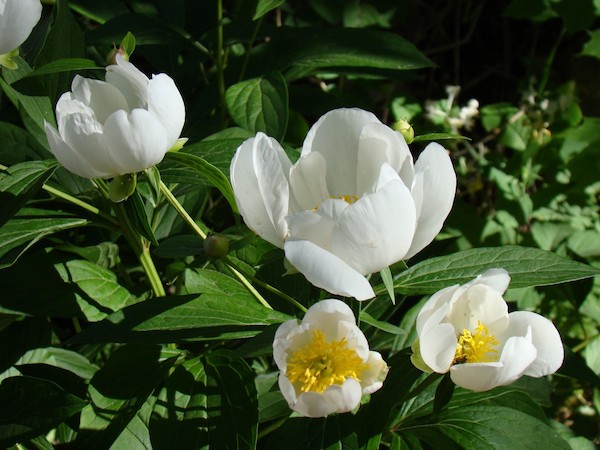
I couldn’t find a photo of my favorite stage in the (perennial) peony’s life-cycle: When the petals begin to fall on the leaf mulch and change color, they create a rich tapestry of decay
Poppy (via).
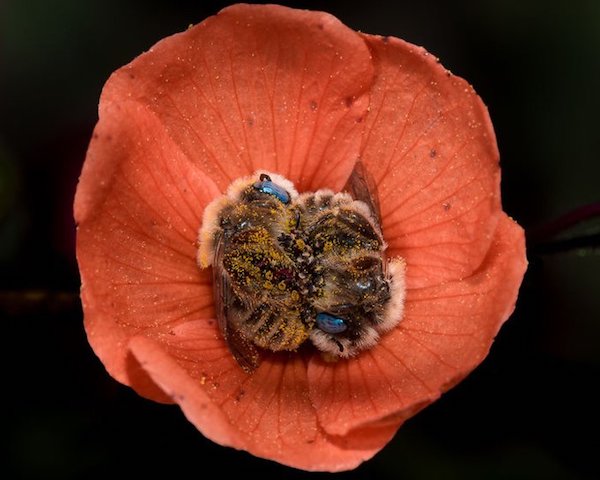
My poppies (reseeding annuals) come from a mix (“Northern Lights“) of wildflower seeds that mature at different times, so there is always something in bloom. Poppies are the last. Like sunflowers, they are strongly heliotropic, and it’s amazing to see them stretching out, almost at a 45° angle, to catch the last of the sun.
Rose (via).
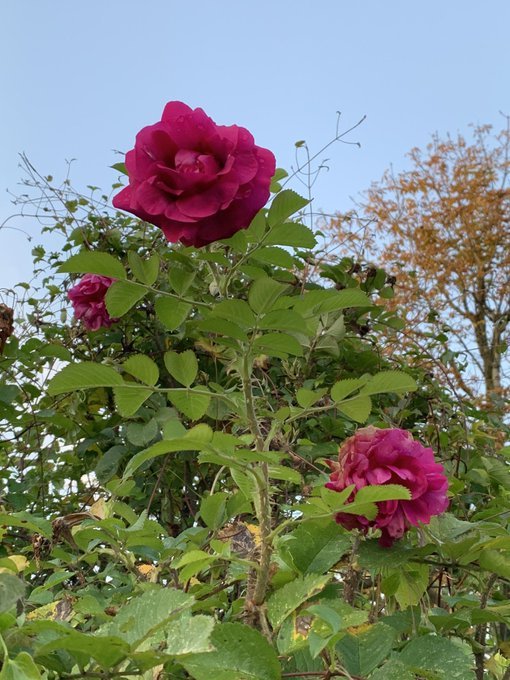
A beach rose, another invasive hardy perennial. We have stacking functions here as well: A lovely scent, with extremely prickly stems that serve as a fence. (Sadly, beach roses are favorites of Japanese beetles, for which I found no remedy that didn’t involve work. I finally ended up using neem oil; I can see no purpose for Japanese beetles, which seem to do nothing in life but eat, and yet don’t serve as food for other creatures. I guess that makes me a poor candidate for Buddhism.)
Squash (via).
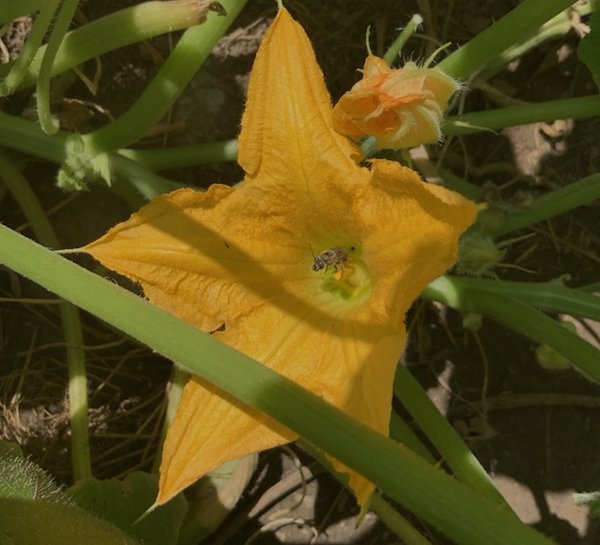
Squash, extremely annual. Squash flowers often come as a pleasant surprise, making a sudden appearance out of the great sun-and-shadow-dappled tangle of vines and tendrils that is a squash patch.
Sunflower (via).
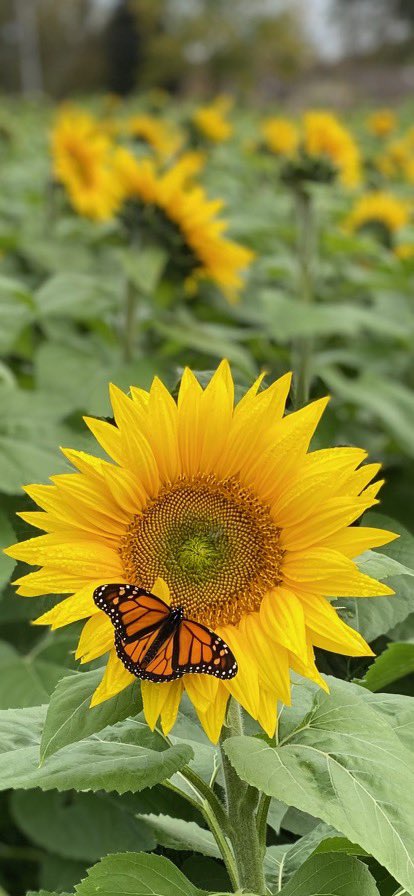
Sunflowers, self-seeding annuals. The more sunflowers, the better! (And that’s what sunflowers think, too; they give off toxins from their roots, leaves, stems, flowers, seeds, etc., that impede the growth of other plants or even kill them. However, where the sunflowers grow, I don’t care if anything else grows, because the ginormous sunflower patch is such a pleasure, to me and to pollinators.)
Tomatos (via).
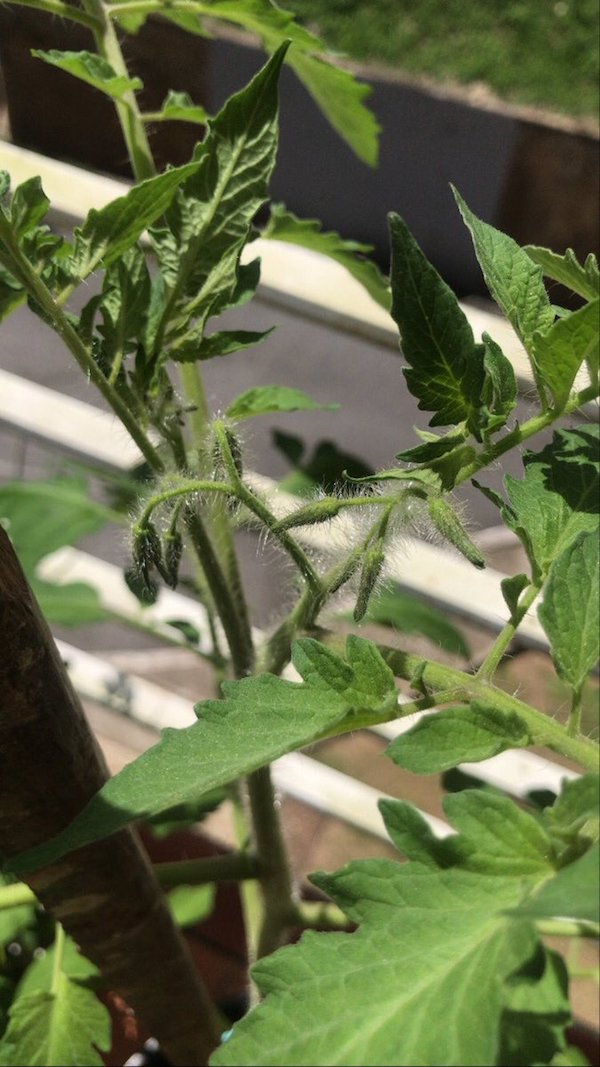
This photograph shows the great moment when you notice your tomatoes (nonhardy perennial) have started to put forth flowers, even if they have not yet bloomed.
Zinnia (via).
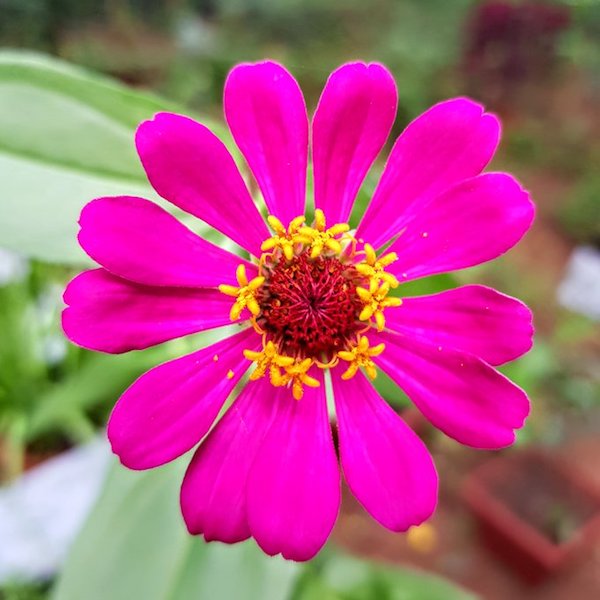
I like zinnias (annual) because they are very easy to grow, they last the whole summmer into the fall, and they come in all colors and sizes. I buy some flats and create masses of colors with them. Pollinators like them too!
So, if you are feeling some angst, as I am, I hope this post brings a little relief. From Michael Pollan’s Botany of Desire (“A Plant’s-Eye View of the World):
This book tells a different kind of story about Man and Nature, one that aims to put us back in the great reciprocal web that is life on Earth. My hope is that by the time you close its covers, things outside (and inside) will look a little different, so that when you see an apple tree across a road or a tulip across a table, it won’t appear quite so alien, so Other. Seeing these plants instead as willing partners in an intimate and reciprocal relationship with us means looking at ourselves a little differently, too: as the objects of other species’ designs and desires, as one of the newer bees in Darwin’s garden – ingenious, sometimes reckless, and remarkably unselfconscious.
I always find “the great reciprocal web” extremely comforting to cotemplate, which I prefer to do from the midst of it. Readers, what are your favorite plants, and why?
NOTES
[1] I’m committed aesthetically to long exposures with great depth of field, and I never have found a way to photograph flowers satisfactorily with that constraint. Flowers seem optimized to move with the breeze, for some reason! And so all I get is colored blurs. Maybe I should try again, and work with that.


Great post happy Sundae
Honeysuckle and squash <3
Beautiful flowers! Many of them, Columbine, Sunflower, Black-eyed Susan, Bee Balm, Honeysuckle, are very beneficial for birds, bees, and insect life. Lesser Goldfinches love to eat Sunflower flowers and leaves. Towhees love Columbine.
Lovely, lovely, flowers. Thanks.
So lovely! Most are my favorites too, but you left out cosmos, a cast-iron flower that attracts crowds of bumblebees and other sundry pollinators. They reseed better than zinnias, but dead-heading them and pitching the heads into the bed helps some. Some of my most heady moments are clipping seed heads as bees zoom past my ears from flower to flower. Almost heaven!
I love cosmos, too, and so do my deer :-(
I wonder how big of a clover buffer/distracter you would need, as Lambert suggested to deter deer. I’m going to have to try it since I too love me some cosmos toward the back of a flower bed.
Goldfinches love to eat cosmo seeds still on the plant. Maybe I will be diligent enough to get also for myself some seeds off of my cosmos.
Over the last few years I would gather seed from the tallest cosmos I saw here and there. I am hoping to get a personal “strain” that leans towards tallness. I planted some of that seed this year and a lot of my cosmos are about 5 feet tall and very flowery. Some need support, some are strong enough to stand up without it.
I hope to get cosmos which will grow a central leader about 10 feet tall or so with the right side-branch pinching. A sort of cosmoquoia- type appearance.
Phytolacca americana, aka pokeweed, poke salad, poke salet plus variations with ‘polk’. Made famous by Elvis’ cover of Tony Joe White’s song Polk Salad Annie. I searched for a nice picture of the plant to include here but it seems everyone has the problem I have of capturing the plant without it looking ugly. This might be selection bias since the majority see this plant as a noxious poisonous weed. In my garden I select and care for a few specimens every year and they are quite attractive. The fruit is a favorite of the birds and makes a very nice jelly and the young plants are tasty greens when prepared like traditional southern turnip or collard greens, with the necessary additional blanching and rinsing. It has medicinal value as well but I will leave that aspect for those more knowledgeable, like Doc Granny, an old folk medicine practitioner and midwife of my childhood in the deep south of Mississippi.
Pokeweed fruits make a nice jelly? Really? They are not poisonous? Not even above a threshhold dose?
How much of the jelly have you eaten at one time? How long have you been eating it? About how much of it do you eat over a year?
How do you make the jelly? Do you have to take care to remove all the tiny seeds at some point? Are the seeds themselves poisonous or harmless if left in the jelly?
Speaking only from experience so no appropriately credentialed proclamation of TRUTHS. My grandparents, who lived into their 90s, their children and grandchildren and many members of the community enjoyed poke jelly and poke syrup (great on vanilla ice cream) made from the ripe fruit. My recollection (up until I was 18, I’m now 60) is that it was made most years and enjoyed in moderation with no ill effect. I do not remember any warnings associated with its consumption. I don’t have any personal knowledge of its preparation though I know the seeds were filtered out, but why, rather for avoidance of toxicity or to improve palatability I don’t know.
It was also used as a fabric dye, and I have experimented with using it as a wood dye, but without good result. I recall reading it was used as an ink.
Poke root was considered an important, and dangerous, medicinal herb, but beyond that I haven’t a clue what they were using it for.
If you are going to grow pokeweed, especially as an ornamental, its probably easiest to cut it back early to force it to send up multiple shoots forming your typical bush at about 4’x4′ at maturity (about 3-4yr plants) I personally train mine as single stalks with mature plants reaching 7′ but these are susceptible to falling over so you have to address that. There are two variegated forms available and they come true from seed but I personally prefer the common green variety.
Well, I hope you have at least found some of this interesting. I’m familiar with all the exhortations concerning its toxicity, and these do apply to consumption of the leaves. I would suggest you follow the recommendations of using only young shoots (we did) and blanching and rinsing several times(did that too) prior to cooking. If you enjoy southern greens I think Its worth trying. Concerning the jelly/syrup, well, I leave that to your own judgement and only say I still count it as one of my two favorites, fig preserves beating it only because of its association with a certain fair haired girl.
Thank you for taking the time to write all this down. I used to eat young pokeweed leaves. When I first heard/read the warnings I felt angry, as if I were being deprived of something. And they are said to contain a “hemaglutinin” ( a clumper-upper of red blood cells) , so as a chronic kidney disease person, I suppose I will only eat a few leaves very rarely for the memories. It sounds like a worthwhile project growing them for shoots. I wonder if pokeweed and asparagus would play well together in the same bed.
I may well try making some pokeberry jelly or syrup or some other product at some point and use it carefully. I wonder if the extreme persistence of the pigment would indicate an extreme presence of beneficial anti-oxidants, though I would not boldly hypothesize that it would.
I have most of these in my yard. Your comment about japanese beetles struck a cord for me. I have 3 climbing roses (lost 2 to them), and probably 15 other rose bushes in my yard.
I tried neem oil this past year only, after prior years of advance bayer…the advanced bayer seemed to have worked better but I tried to stay away from it and then for the first time in many years the grubs got my grass even though put grubex down faithfully. Small patch of grass bordering the roses.
So at 68 and I just lost my husband i am considering digging them all up and throwing after 21 years….sad. But, I don’t need the maintenance anymore and they attract them to my yard..Thinking ahead.
KB, I am very, very sorry for the loss of your husband.
I’m so sorry, KB. No words.
Thank you. He was a Vietnam Veteran who worked the boiler room in the oldest submarine tender in the fleet at the time. They threw asbestosis around like leaves blowing in the wind. An awful 16 month journey and due to covid the last 7 months at home in hospice…An incredible fight he put up till the end..Buried at Fort Snelling with full military honors, thank God, as Governor Walz only recently allowed it. Still only a few people allowed but the honor was most appreciated.
I wish I could hug you. So very sorry.
KB, my sympathy for your loss.
KB, the Japanese beetle pheromone traps really do work. You might try them out next year. Those little pests are aggravating, they eat all the good stuff.
Actually, cocomaan, the University of MN extension service announced years ago, they only attract more to the neighborhood…maybe 10 years ago I used them and can personally attest to the same…I now regularly try to point people to the research so they don’t use them. They have IMHO brought more to the area and they shouldn’t be sold. The japs should be moving west in a 3 year cycle, but cause of the traps they come now in waves…And worse, the grubex apparently is no longer effective…..
Ugh, that’s terrible. I tried Milky Spore but ended up finding out that my chickens were pretty good at dispatching them! Good luck. Hope you don’t have to tear anything out.
Maybe Milky spore for the grub stage (which your chickens took care of) and an insecticide like Seven applied mid-height of the rose bush for the adult stage? Growing roses in the upper Midwest is a challenge. Winter is coming so the pests should be dormant in the upper Midwest for the next several months.
Looks like a job for IPM!
The chickens actually love the grubs AND love the mature ones too. They go insane for them.
They say if you crush them it also attracts more. You have to get rid of them discreetly. But usually their season is short — at least here.
I treat the Japanese beetles as a spiritual-growth-and-discipline opportunity. Perhaps that IS their reason.
If there are dozens and dozens or hundreds or more, then I have to “do something”. If there are only a few, then I can just watch them. Pretty little bronze and green metallic shiny beetles. And over the last 5 or so years there have been only a steady few.
The year before that there were many dozens but not quite hundreds. I would go out early in the morning when the morning cool had them all still or slow-moving in place. I would put a few drops of olive oil on each one. They died thrashing from oxygen deprivation within a few seconds to a minute. Why olive oil in particular? So they would die happy.
And now that I think about it, the J beetles taught me stealth and stalking too. I got all the easy-to-kill ones in the first few rounds, leaving myself with the vibration-sensitive ones who would tuck in their legs and roll-drop off the leaf into hiding on the ground at the least hint of any vibration. I had to really learn how to get the oil-dispensing tip right above them without setting them off, down and away.
I’ve had luck with planting a grape vine to draw them away from other veggies and flowers. It grows fast enough that the beetles haven’t been able to hurt it, and they seem to prefer it.
Also this year I started giving it an annoyed flick when I saw one on a flower – out of frustration at first because I couldn’t do much else without bothering the bees working in the area. Surprisingly it appeared to be effective – many fewer this year than previously. Maybe they got the message and bugged out, or it was just a coincidence. It could be worth a try.
It really can be tough to discourage Japanese beetles, if they have a nice patch of grass right next to some very old rose bushes (decades old, including ramblers, planted in clay soil with amendments but no organic matter). I accidentally got rid of them, trying to improve the soil and plant 6 packs of flowers that would enjoy a little reduced sun, under a rose bush.
That’s fiddly work though, that I am not sure is worth doing, if you are sure you also have them in the grass. At my age (same as you), I would not do it more than once or twice, if the Japanese beetles survive the work. I used an asparagus knife (like a longer, stronger screwdriver with a flattened end that is notched, that is sometimes called a weeder) and would feel terrible every time I accidentally snapped a rose bush root. I was frankly suprised that instead of killing the rose bushes, I resuscitated them.
I may also have been lucky in attracting suburban and wild critters (possums and birds) that will actually tackle japanese beetles, from all the enriching of the soil I did.
KB, I’m very sorry. Sending a hug.
Thanks for the lovely photos, Lambert. I especially like the sunflower and butterfly.
My poor mother has been in hospital off and on all summer and just moved into an assisted care place :((
So I sent her the link to brighten her day. These simple visual pleasures and memories of gardens past can make a huge difference in my experience. And we need all the help we can get these days!
Yes. Peonies and Iris around Memorial Day and family picnics. Columbine in the cool, shady garden spot, an unexpected lovely surprise. Zinnias in the heat of summer and softball games. Whole seasons of good memories captured in a few photos.
My fav is the tall bearded Iris with it’s fragrance because… no wait, my favorite is the Black-eyed Susan with it’s sunny disposition winking from the roadsides and pastures because… no wait, my favorite is …. :)
Pavel, it’s so hard to have a loved one with a lingering illness. My sympathies.
Love these posts. Jerri Lynn with the chocolate, Lambert with the flowers, wonder what Yves will have?
Lambert, I highly recommend Mountain Mint. https://www.motherearthliving.com/plant-profile/herb-to-know-mountain-mint
Easy to grow (as low as zone 4 up to zone 8), nice looking flower, and holy Toledo does it bring in the pollinators. I’ve counted twenty to twenty five different species of pollinators on my mountain mint patch at any one time. It also makes a great addition to iced tea.
Otherwise, my favorite from your list is Iris, the things smell like candy!
WHERE IS THE CHOCOLATE
/off to find the link
If you find it, would you please post? I meant to keep it, but you know how that goes. It was maybe a week ago
https://www.nakedcapitalism.com/2020/10/eating-more-chocolate-a-cure-for-pandemic-fatigue.html
I used to spend hundreds of dollars on flats of annual flowers. Now I start everything from seed or bulb for less than $25, with much more variety.
Like Lambert, I’m a zinnia fan. There are dozens of varieties, all beautiful. When they get to about 2 inches, I thin them and replant the thinned ones elsewhere. One thinned row creates another five or six rows. A couple of $1.99 packets fills up most of the gardens in our yard.
Thank you for including the tomato and squash. We focus on their functionality and forget their beauty.
Zinnias sometimes make for great seed collecting. I have zinnias I keep planting again and again that bloom at the time of the wedding the original 6 packs of flowers were bought for. Then there are the bushier big pom pom flowered ones, etc.
I collect lots of my favorites, some I’ve been collecting for decades, often from a 6 pack that was a keeper. I collect some favorite columbine seeds, and wild penstamen/snapdragon, the less common nasturtium colors, etc.
My favorite for the last 3 years is a tiny daisy like plant, that looks like an alyssum that is bigger than all the rest, until it shoots out longer stems that divide and explode in multiple flowers, each of the blooms lasting for many weeks. I got them from Annie’s Annuals, described as a daisy like flower from Africa, that was sold only for one season. I suspect that it is really some member of the aster family. It will even self seed, but likes moist, rich, soil, with not too blazing sun, to germinate. Then it likes more sun and regular water, so I don’t think it’s native to northern CA.
I am moving to zone 4 soon, so I will have a MUCH shorter growing season, and a chance to try to see what flowers I can’t kill.
Saving flower seeds, for me, is like being a miser who has unlimited coins to count: great fun!
Zone 4!!! Ouch!!! My zinnias don’t reseed, but I buy a couple of packs of seeds.yearly. i think it’s the short summer.
Yep, ouch (although I should say it’s a protected valley that’s mostly zone 5).
I’ve never seen zinnia self seed, but it’s easy to collect if you can let some blooms dry out good and brown, on healthy plants. It only takes a few minutes. Here’s a quick step by step guide to collecting favorite zinnias: https://www.thespruce.com/how-to-save-zinnia-seeds-2539566
Lambert, you just described, to a plant, our garden 30 miles south of Chicago. This year was spectacular, with our two rose bushes from the 1930’s blooming twice. Just add some hydrangeas, and greens, most of which we end up donating to our local food bank(s).
> Lambert, you just described, to a plant, our garden 30 miles south of Chicago
Perhaps both derive from the design thinking behind a “Grandmother’s Garden” (here, here)* I know mine does. I grew up in the Midwest, and others mention how Midwestern this selection feels, too. So, a Midwestern Grandmother’s garden…
* Key element: Masses of color, like, say, a Monet.
Zinnia fan here, too. Equally as a source of natural beauty to look at, my garden serves as a source of cut flowers for the house – and zinnias make absolutely splendid, long lasting arrangements. Unfortunately where I’m living now we do not have the dry heat late summer that zinnias love most and they are highly susceptible to mildew. Sigh
Paeonies, also, are another of my favourites which are much more successful here – and the ones I’ve planted were sourced from flower trade nurseries so as to have the tall stems
Definitely near the very top of my list are alstroemerias in wonderful deep reds, oranges and whites. There are many dirty pinks and beiges etc too, which are better avoided on aesthetic grounds, in my opinion
Not sure if your spelling of ‘paeonies’ is non-US or what, but it evoked Paeon, the god’s doctor, and also a hymn of praise.
Fair are the meadows,
Fairer still the woodlands,
Clothed in their twinkling
garb of spring.
– from the 1960 Methodist Hymnal.
or A. E. Housman’s poem ‘Loveliest of Trees’ :
Loveliest of trees, the cherry now
Is hung with bloom along the bough,
And stands about the woodland ride
Wearing white for Eastertide.
Now, of my threescore years and ten,
Twenty will not come again,
And take from seventy springs a score,
It only leaves me fifty more.
And since to look at things in bloom
Fifty springs are little room,
About the woodlands I will go
To see the cherry hung with snow.
a favorite:
The Trees
The trees are coming into leaf
Like something almost being said;
The recent buds relax and spread,
Their greenness is a kind of grief.
Is it that they are born again
And we grow old? No, they die too,
Their yearly trick of looking new
Is written down in rings of grain.
Yet still the unresting castles thresh
In fullgrown thickness every May.
Last year is dead, they seem to say,
Begin afresh, afresh, afresh.
Philip Larkin
I haven’t found (or brought back to life) an alstroemeria that wasn’t a killer for the garden as well as the vase, and regularly divide a pink spotted with bronze and yellow for friends. Such a spectacular flower in a big pot, next to a big pot of cymbidium, so you have big flowers for much of the year in northern CA.
You left out the snapdragon? Its form is so beautiful! Also wisteria, physostegia, but yes so many beautiful flowers in the world.
When I was a child they grew in my grandmother’s garden. They were my favorite flowers for years. I haven’t seen them though since we moved to Kansas. Lately morning glories have been my favorite.
But your reminder of snapdragons makes me wonder……
In northern CA, I buy my snapdragons in 6 packs. Like petunias they want a warm night to germinate, so unless I have a green house, I can’t plant seed early enough to grow as long as they can (I’ve had a couple last 2 seasons, when we didn’t get any real freeze at all). I imagine that Kansas is even colder than northern CA. Mixed among marigolds, they can be showy and then be left alone (while the marigold finally explodes after growing from seed), and I can get more late summer blooms.
I’ve noticed that the most popularly stocked 6 packs of granny favorite seedlings nowadays are sold root bound and already blooming, which means elderly and nothing that will spread out and really thrive for me, so I make sure I buy actual seedlings that aren’t already root bound/flowering.
I like birds of paradise, but are tropical. It was so nice in Hawaii, seeing them growing in front of houses.
In Oregon, my grandmother lived with us and had a very nice garden, particularly the gladiolas.
The first time I saw a birds of paradise arrangement, shortly after moving to So. Cal., I thought they were too striking to be real lol.
My mom grew birds of paradise in our atrium (in Marin County, CA). My bedroom had a sliding door into it and I loved keeping the curtains open to look at them. So exotic and beautiful!! Add this to delights I miss since moving to Kansas!
Sweeeeeet peas!!!
Next year–I’m concentrating on flowers. Bouquet making satisfies all the urges, and giving them away brings joy and beauty to the daily drudge.
You might enjoy this book: https://www.booktopia.com.au/flower-colour-guide-darroch-putnam/book/9780714878300.html
I got it more as a dictionary but I imagine it’d be useful for making bouquets as well. They have another one coming out next year which seems to go into arrangement in more detail
It’s okay to say a lot of flowers are your favourite. No need to limit one’s self in that department…
I always put in zinnias, cosmos, glads, dahlias, and sunflowers. The birds and bees love them. This year, I put in some weird marigolds I found at the nursery, called Cracker Joe(not Crackerjack). They had big orange blooms and were at least 3′ tall and very bushy. Fantastic! It seems to be a rare variety so I saved what seeds I could for next year. Some day if I ever get a house, I’ll go bananas on roses as they are my real favourite. I miss growing them.
You will, you will :-)
In thinking of flowers, I often think of “Schneeglöckchen” – literally snow bells or Snowdrops which I first came across in Germany. Something about how ephemeral they are and only growing at certain times of the year always intrigued me. Not your typical flower-
https://en.wikipedia.org/wiki/Galanthus
Lambert Strether: Your list is an evocation of the culture and visual field of the Great Lakes States. Every one of these flowers looms large in the consciousness of anyone who grew up here or lives here.
I’d add: I like the blue phase of bee balm. That blue/lavender flower is stylish and elegant. They are stalwarts.
I’d add: As to peonies, I will take anything. They are always a wonder. The deciduous peony comes across as indestructible. Then there are the wonderful flowers–layers and layers of petals with a fleshy sensuality. And should I even mention the fragrance. Colette wrote that the scent of peonies is slightly fetid, and it is, as if to remind us that we are mortal.
I’d suggest: Prairie flowers. But there are so many–the names escape me. Yet when I walk through the small restored prairie in the park connected to a high school near me, I think that the prairie flowers–seven, eight feet tall, heavy with flowers, abuzz with bees of several species–somehow call us to be better than we are. That we should do some work to deserve them.
Fields of lupines in Texas hill country. Acres of poppies in Calif desert. Breathtaking.
I love lupines! I live in upstate NY and there are a few preserves that have fields of wild lupine to support the Karner Blue butterfly.
Lovely flowers, Lambert. I moved to the Midwest 2 years ago and when spring rolled around, the most beautiful flowers came up in my garden. I didn’t know what they were – it turns out they’re bee balm and the hummingbirds really love them. I didn’t know you could take out clumps and plant them elsewhere. I plan to do that. I planted crocus and daffodil bulbs recently to have early spring flowers. So many of the plants I see here are ones I never heard of – like hostas and snowballs (which I thought were hydrangeas). Northern California has flowers that won’t grow here – I especially love rosemary and thyme.Would love to have peonies and iris. We’ve also had an invasion of Japanese beetles this past summer. I wasn’t aware of the pheromone trap being not such a good idea, but that’s what people suggested. Now i Know.
Thanks for reminding us how beautiful nature is.
What, no lobelias from those on the fake Blue™ Left Coast (California in this instance)?
In that clime, lobelia will thrive in the neglected sidewalk cracks where renters desperately spent unreimbursed money (I spent well over a thousand) to cheer up their desolate apartment premises. It’s anyone’s guess as to whether renters don’t pour out for far, far more of their disposable income than property owners to bring some pleasure into a bleak, demeaning and horrid existance, but I will definately bet – and stake – my life on the renters.
Ahh well, those lobelia planting renters are not posting here because they are now sleeping on cement, with no chocolate in sight; oddly,California is a proclaimed center of socialism when it never ever has been, just ask Joan Didion. whom it took near her entire life to realize, how very CRUEL the Golden State actually is.
If anyone has Netflix, I highly recommend Moving Art Season 1 Episode 2 Flowers. Actually all of Season 1 is just gorgeous and relaxing.
Lambert, thank you for this uplifting post. Your choices are lovely. Columbine is a special favorite. It grows wild in the Sierras and Rockies.
@The Rev Kev
Galanthus were called Star of Bethlehem where I was born, near the US Atlantic Coast in a watery, so called Blue™ City and State, just above the Mason Dixon Line. they came up through the snow, along with the crocus, and had intricate green veining on the inside of their drooping white petals. the narcissus and hyacinth followed, then the tulips, and then the wild violets (which didn’t need to be planted) and the Lily of the Valley (which only needed to be planted once in those places where it freezes in the winter), then the glorious bearded iris (rhizomes, not bulbs, which bloom earlier) as I recollect. In the Mid West, the hollyhock was a predominant and glorious biennial, which self seeds; on the Pacific Coast, the pansy is glorious with a subtle and beautiful scent. So many other flowers not mentioned …
The lovely tiger lily, and edible daylilies …
I agree that it is fine to have many co-equally favorite flowers and flowering plants. Over time I am getting more interested in commonly known hard-wearing hardy good-bloomers who attract many pollinator insects.
Goldenrod (solidago) does that. So does fennel (foeniculum I think). So does Althea zebrina, in the mallow family.
Here is a video showing pollinator insects at goldenrod flowers.
https://www.youtube.com/watch?v=URbCjM8Pix0
The most spectacular flowering-plant I have ever seen for attracting pollinator insects is the hercules club/devils walking stick tree ( Aralia somethingorother). It has huge inflorescences of thousands of tiny flowers and the whole mass can attract thousands of insects if there are thousands of insects around to be attracted. I found a minute plus long video to give a faint impression of what I used to see in East Tennessee at these plants. Maybe some day I will grow them at the back edge of my micro-yardlet.
https://www.youtube.com/watch?v=k8Yj6jv7vfw
Every one of these flowers becomes a berry. In fall these trees lure in many tens of birds at a time sometimes to eat the berries. Best video I could find, sorry about the long URL address thingy.
https://video.search.yahoo.com/search/video?fr=sfp&p=you+tube+devil%27s+walking+stick+tree+birds+eating+berries#id=2&vid=ee4e3f5117253328308f574c4c9c84f0&action=click
Plants as partners–
Thomas Berry speaks in a broader sense of this mutual relationship:
And his core contention:
As for flowers, I’d mention echinacea, the magical spiderwort, the humble bachelor button and daisies, in part because of this video.
Thanks so much for this lovely post. It really lifted my spirits on a dreary, cold, rainy October day! We share many favorites.
Love this post! This has been the year of gardening for me as I am living in a house for the first time in 40 years. Does Milkweed count as a “flower”? Their seed pods are bursting forth right now so I took a bunch yesterday while on a hike. They say if you plant them in the fall and allow them to winter over they will grow in the spring. Plan on putting them in the sunniest part of my yard.
Lambert – Have you ever tasted the honey in the honeysuckle flower? You can extract it quite easily.
I haven’t read all the comments, so someone else may have mentioned this, or you may know it already.
Pinch off the flower at the stem, below the green base. Take this green base between your fingertips, gently separating it from the white or yellow flower. Slowly pull the fiber through the flower. It’s connected to the stamen and the bulb of the stamen will come out with a small drop of honey on the end. Very tasty.
Great post. A lot of your favorites are mine also.
Have you seen the film (from 2017) The Gardener? I just saw it and was inspired.
“White Coral Bells Upon a slender stalk Lilies of the valley deck my garden walk Oh, don’t you wish that you might hear them ring? That will happen only when the fairies sing.”
a traditional childhood song from nursery school.
My favorite are the roses, the climbers, the dreamers, the adventurous, the miniature be they
apricot, cameo, shell pink white, wine, coral, tropical, yellow, gold; or other so long as they are traditional, old stock with fragrances to swoon by… their soft sweetly unfurled velvet petals… from Venus, no doubt…..
That looks like Japanese honeysuckle (Lonicera japonica) which is an invasive non-native flowering vine https://www.invasive.org/alien/pubs/midatlantic/loja.htm
If so, I strongly recommend a much friendlier and very pretty native replacement, Trumpet (or Coral) honeysuckle (Lonicera sempervirens) https://www.wildflower.org/plants/result.php?id_plant=lose
Hummingbirds love it and so do a number of long-tongued butterflies and other insects. “Major Wheeler” flowers from May to October in my garden. Every year we have a couple of hummingbirds that put it on their regular daily garden tour. L. sempervirens v. sulphurea “John Clayton” is a yellow variant.
I just had to get back to this and express my delight at this post.
Wonderful choices and many associations have been conjured up.
When we moved to the farm in 1964 we had two flowering things already established (the cut up Homestead had originally been established in the early mid 1800s in the Firelands of Ohio)–White and Purple Lilacs and a row of Peony along the drive. This sparseness seemed very common in the township located at the edge of Appalachia, settled by the Welsh.
We had moved from the country surrounding Cleveland’s suburbs to the real country. For two and half years prior we lived next to(and i was looked after by) the Schulls–Clarence and Mary(both b. 1904). Their influence on me for this short period, in reflection, was profound. Unc had his own skill set, but Aunt Mary was the Naturalist. With the exception of Columbine and Honeysuckle, she had your entire list in her yard somewhere and I was introduced to them all. Forsythia was prominent through several windows and long beds of yellow daffodils highlighted areas of the yard. Their House, garage, garden shed and Master bedroom was yellow. Today Yellow and Green are my favorite color combination, and my house is painted so. And, for me, Spring arrives with eager Daffodils and Forsythia.
We picked and she breaded and fried Squash flowers for summer brunch(the break before the heat after working outside since early)or supper. Fried Flowers! In her youth she had followed her Mother to employment at the Hale Farm kitchen, to tend the Herb Garden and then to cook. Boy could she cook( i was her kitchen help and she tried but nothing really took, unlike Trees/Birds and Plants(interest not adeptness).
https://en.wikipedia.org/wiki/Hale_Farm_and_Village
My Mothers take on this was “Don’t plant anything you have to weed to make pretty” and that seemed to be internalized by me very quickly as i tried desperately to do my part to help ensure we had something to eat out of the garden come fall. Her take on that came directly from having to leave home at 14 during the Depression and go to work/shelter with her Mothers friend who owned the Fleet Avenue Flower Shop. She Truck Farmed and weeded for three growing seasons until she found a way to Waitress her way out of farming–for another 30 years. Ironically, she worked at the owners Truck and Flower farm in the country a mile from where the Schulls built their house after WWII.
Despite Moms inclination, after reading Silent Spring by Rachel Carson, she made sure Aunt Mary got a copy and when Aunt Mary spoke to her Garden Club about it, bought everyone in that Garden Club Silent Spring. She also made me read it–out loud to her–so she could help me with the words and their meanings–practicing what Adults do to gain understanding of their world.
I have lived in the South (though I do hold onto our Ohio Homested), again, for many years. My place here was set up by two spinster sisters, heirs to a modest Southern Legacy family, that reflects their appreciation of Nature–modestly. No Magnolia/Camilla/or Azalea show for them, yet their chosen plantings give me flowers and scent eleven of the twelve months.(but this has been changed by the ongoing change in Climate caused by us humans–my December Daffodils tell that story themselves).
Winter Honeysuckle(Lonicera fragrantissima) in early January is a reminder that change is coming, soon followed in February by Winter Jasmine(which I thought was Forsythia for years) and later Daffodils. Then it is on until the huge Tea Olives wrap early November in their fruity scent and presage winter with snow like drifts of spent flowers on the ground. In between there is Abelia Grandiflora, Gardenia, Rose of Sharon and many more. The sisters liked shrubs with flowers way more than flowers, maybe for my Mothers reasons.
Of course I have added the Magnolia and Azaleas, and some Camellias(which are rewarding me right now.) and Irises/Lilies/Daffodils and others–mostly “found”. I have a small bed of Spring Starflowers( Ipheion, are in the Amaryllis family)
In ending this essay excursion, I will admit to a recent affair with some most excellent Naked Ladys I liberated from a sold lot about to get graded. Planted three years ago, the girls showed up in their finest this year—MAGIC. https://www.easytogrowbulbs.com/products/lycoris-radiata-trio?variant=42686311308
Ya’ll have something special going on here, the Information, the Eclectics, and the Readers. I thank you and all for keeping it up and believe your service in this radiates wide. FYI–I got here through a reader comment on Matt Taibbi in the Rolling Stone during the GR..
PS–Robert J Lurtsema had a wonderful idea, and however you happened on it, putting it at the head of WC was inspired and inspiring. Thanks.
Here is a link to a permaculture guy’s ask-me-anything entry on Reddit. I will copy-paste the relevant material from another comment I wrote elsewhere and put it here so it may be more easily found if so desired.
What prompted me to get on here and write this? An “ask me anything” reddit I just saw. And here it is.
https://www.reddit.com/r/IAmA/comments/jqgr6j/i_desperately_wish_to_infect_a_million_brains/
And the very first sentence reads like this.
“I desperately wish to infect a million brains with ideas about how to cut our personal carbon footprint. AMA!”
It is by Paul Wheaton. Who is Paul Wheaton? Here is a link to a wiki about him offering all kinds of provenance and bona fides and links to readable stuff he has written and listenable stuff he has recorded.
https://en.wikipedia.org/wiki/Paul_Wheaton
I am also going to place a briefer version of this comment with the Paul Wheaton material on the most recent ( top of its page) entry under the Permaculture category. So that people can find it later if they wish.